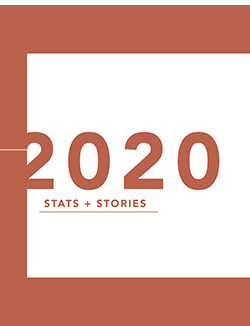By Kent E. Fillinger
The year 2020 was, well . . . different! And, because of that, we knew it was super important to capture the stories and statistics from 2020 to gauge the true impact of the COVID-19 pandemic on our churches and establish baselines to measure future growth and changes.
We made major changes to our annual church survey to better reflect the uniqueness of church ministry in 2020. Therefore, you will see a mix of new and familiar data in this report. A total of 421 churches bravely reported their data, and we appreciate each one’s contribution to our annual research.
Determining Church Sizes In 2020
In all previous years, it was easy to determine which size category a church fit into based on their average weekly worship attendance. For 2020, we adjusted our process while maintaining the same six church-size categories: megachurches (average weekly worship attendance of 2,000 or more), emerging megachurches (averaging 1,000 to 1,999), large churches (500 to 999), medium (250 to 499), small (100 to 249), and very small churches (99 or fewer).
In the survey, we asked churches to report their in-person, online, and total average worship attendance prior to the arrival of COVID-19 in the first part of 2020. We also asked churches to report their average online worship attendance for the weeks when no in-person gatherings took place. Then, we asked churches to report their in-person, online, and total average attendance for the weekends after they regathered for in-person services.
I took each church’s pre-COVID-19 total attendance, and the attendance after regathering (when a church resumed offering in-person services), and I averaged these two numbers to get an estimated total average worship attendance for 2020. We used this combined average worship attendance figure to determine each church’s size category for last year. All other research statistics were calculated based on combined average worship attendances.
Shift from In-Person to Online Church Attendance
The pandemic impacted worship gatherings by shifting attendance from in-person to online. Looking beyond a church’s geographical location—which we know impacted their ability and willingness to meet in-person—we determined that churches of various size categories shut down in-person services for varying amounts of time during 2020. For example, the average very small church held more in-person worship services (40 weekends) than any other church size category last year. By comparison, the average megachurch met in-person only 33 weekends. The overall average number of in-person worship weekends among churches we surveyed was 37 in 2020.
By the time of our survey, in-person attendance had recovered to 51 percent of its pre-COVID-19 levels. Very small churches have seen the greatest rebound of in-person worship attendance, with an average of 62 percent of attendees returning. Megachurches experienced the smallest rebound of in-person worship, with just over a one-third (35 percent) returning.
At the end of 2020, the percentage of people participating in online worship remained high. After “regathering,” 50 percent of worship attendance was taking place online, compared with only 8 percent before the pandemic. At megachurches, online worship attendance grew from 18 percent pre-pandemic to 70 percent after regathering. Small churches saw their online worship attendance soar from 3 percent pre-pandemic to 37 percent after regathering.
More insights on the digital strategies used by the churches in our study will be shared in a future article.
Attendance Trends
Average worship attendance at the start of 2020 virtually mirrored the 2019 year-end averages for all six church size categories.
Total average attendance for the 421 churches after regathering declined an average 2.7 percent compared to their pre-COVID-19 attendance. The two largest declines were among very small churches (8.8 percent) and megachurches (6.6 percent). Attendance at emerging megachurches held steady. Medium church and small church attendance both increased by just over 1 percent after regathering.
Nearly every church was online-only at Easter in 2020, and overall attendance was down 8 percent for those weekend services compared with 2019 (826,885 vs. 899,577). Only megachurches and small churches saw an increase in Easter attendance.
Last year, 57 percent of all Christmas Eve worship attendees watched online, and total attendance for these services declined 30 percent compared with 2019.
A Big Dip in Baptisms
Churches saw a significant dip in baptisms last year. The total number of baptisms in 2019 was 32,139 among the 439 churches that participated in the survey—an average of 96 baptisms per church. In 2020, there were 13,502 baptisms among 421 churches—an average of 33 baptisms per church. The year-over-year decline was 66 percent.
Among the various categories, megachurches saw a 61 percent decrease in baptisms—the biggest decline—while small churches had the littlest decline, just 1 percent. Emerging megachurches, large churches, and medium churches all saw total baptisms decrease more than 50 percent from 2019 to 2020.
A Generally Good Financial Picture
When COVID-19 forced churches to cease in-person gatherings for several weeks, most church leaders were concerned about how congregational giving would be impacted.
Our survey found that 69 percent of the churches reported giving either met or exceeded their budget in 2020, the same percentage as in 2019. Medium churches fared the best, with 81 percent either meeting or exceeding budget last year. Those most likely to experience giving that fell short of budget were emerging megachurches (42 percent) and megachurches (39 percent).
Two-thirds of churches (67 percent) decreased ministry spending in 2020, which was significantly greater than the 14 percent that decreased spending in 2019. Only 16 percent of churches increased ministry spending last year compared with 48 percent in 2019.
In 2020, almost two-thirds of churches (62 percent) applied for and received federal funds through the Paycheck Protection Program (PPP), part of the Coronavirus Aid, Relief, and Economic Security (CARES) Act. Those most likely to receive these forgivable loans were emerging megachurches (83 percent); very small churches were the least likely to receive a loan (21 percent). Interestingly, churches that did not receive PPP funds were more likely to see total giving meet or exceed their budget last year (77 percent) than churches that received PPP funds (65 percent).
Our survey sought to better understand the full financial impact of COVID-19 on church giving. We asked churches to compare their giving from the most recent pandemic-impacted fiscal year (2020) to the prior, pre-COVID-19 fiscal year (2019).
Overall, 21 percent of churches said giving in 2020 was about the same as the year prior.
Among the churches seeing improvement, 28 percent said giving increased 1 to 9 percent in 2020 compared with the year before, 13 percent of churches said giving increased 10 to 19 percent, and 7 percent said giving jumped more than 20 percent.
But the survey found almost one-third of churches (31 percent) saw a definite downturn in giving last year, with 19 percent seeing a 1 to 9 percent drop in giving in 2020 compared with the year before, 8 percent of churches saying giving decreased 10-19 percent, and just over 4 percent indicating giving fell 20 percent or more.
Medium churches fared the best, as 83 percent saw giving in 2020 that was at or above 2019 levels. Emerging megachurches seemed to experience the biggest struggles, but 61 percent still reported 2020 giving that was at or above the prior year.
Amid the pandemic, over half of the churches (59 percent) increased their cash reserves or savings in 2020, and another 26 percent were able to maintain their cash reserves; only 14 percent of churches saw a decrease. The average church had 13 weeks of operational expenses in reserve in 2020, a better than three-week improvement over 2019.
Some random cash reserve findings: 25 percent of churches reported more than 21 weeks of cash on hand; large churches and very small churches had the most cash reserves, averaging just over 14 weeks; and megachurches had the least in reserve, averaging just under 12 weeks.
On a positive note, 85 percent of the churches said they were “optimistic” in their outlook of the future financial condition of their church. Only 1 percent of respondents said they were “pessimistic” about their church’s financial future, while 10 percent were “uncertain” what the days ahead would bring.
How Ministry Changed During the Pandemic
Churches and church leaders pivoted several times during the ever-changing landscape of pandemic-related rules, regulations, and restrictions in 2020. Creativity, flexibility, and fortitude were necessary as churches strove to develop new methods for maintaining and carrying out the mission and ministry of the church.
We sought to better understand how our churches responded to the pandemic—what was prioritized and what changed—based on a close examination of 21 specific facets of ministry. To that end, we asked churches to identify which of the 21 facets they were doing pre-pandemic . . . and during the closures . . . and after regathering for in-person services.
The greatest increase in a specific ministry method was in providing online children’s ministry lessons; prior to COVID-19, only 6 percent of churches served children in this way, but that spiked to 76 percent during the closures. A very similar increase occurred with student ministry, as only 5 percent of churches provided online lessons prior to the pandemic, but that increased to 72 percent during the closures. While those numbers declined after regathering, 55 percent of churches continue to offer online opportunities to children and 45 percent have continued with this ministry to students.
Churches also added online special events and hangout sessions for students and children. During closures, 69 percent of churches offered such ministry for students, and 61 percent provided this ministry for children; after regathering, that declined to 41 percent (students) and 36 percent (children).
In the arena of ministry to adults, online devotions—whether live or recorded—became very popular during the closures. Only 12 percent of churches offered online devotions prior to the pandemic, but that increased to 69 percent during the closures and continued at 49 percent after regathering.
The pandemic also changed small-group ministry. Prior to COVID-19, only 9 percent of the churches surveyed offered online small groups, but this increased to 73 percent during the closures and remained at 64 percent after regathering.
The use of online prerecorded videos of weekend worship also increased dramatically during the closures, with 78 percent of churches offering this option, up from 22 percent prior to the pandemic. About half the churches (48 percent) continued to offer these prerecorded worship services online after regathering.
Many churches added digital “hosts” or ministers to interact with online worship attendees during the closures—only 14 percent of churches had people serving in this role before coronavirus, but 63 percent had them during church closures (and that dropped very slightly to 61 percent after regathering). Digital welcome or connection cards used to track the number of people worshipping online were more common during the closures, increasing from 30 percent prior to the disruption to 59 percent after the pandemic’s arrival (and that increased slightly to 61 percent after regathering).
The Ongoing Impact of COVID-19
Our survey asked church leaders to project how far into the future they expected their church to experience negative effects from the pandemic. The largest percentage (38 percent) said they expected negative effects to linger an additional 6 to 12 months—effectively throughout all of 2021. Almost one-third of church leaders (31 percent) said they anticipated negative effects would continue for more than 12 months . . . into 2022. One-fifth of the churches forecasted the negative effects of COVID-19 would continue for up to six months but end during 2021. (Just more than one in ten churches expected no ongoing impact.)



0 Comments
Trackbacks/Pingbacks